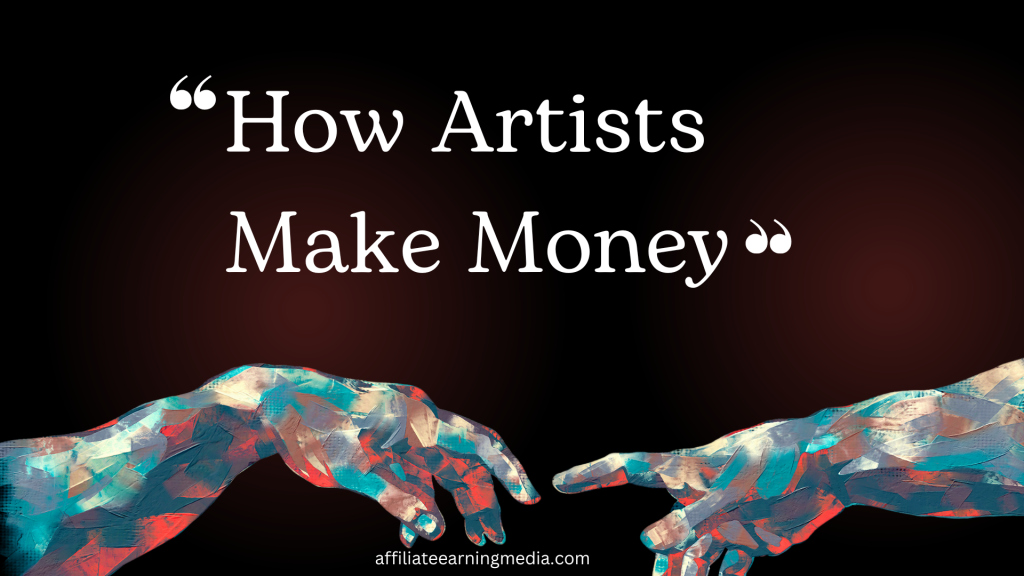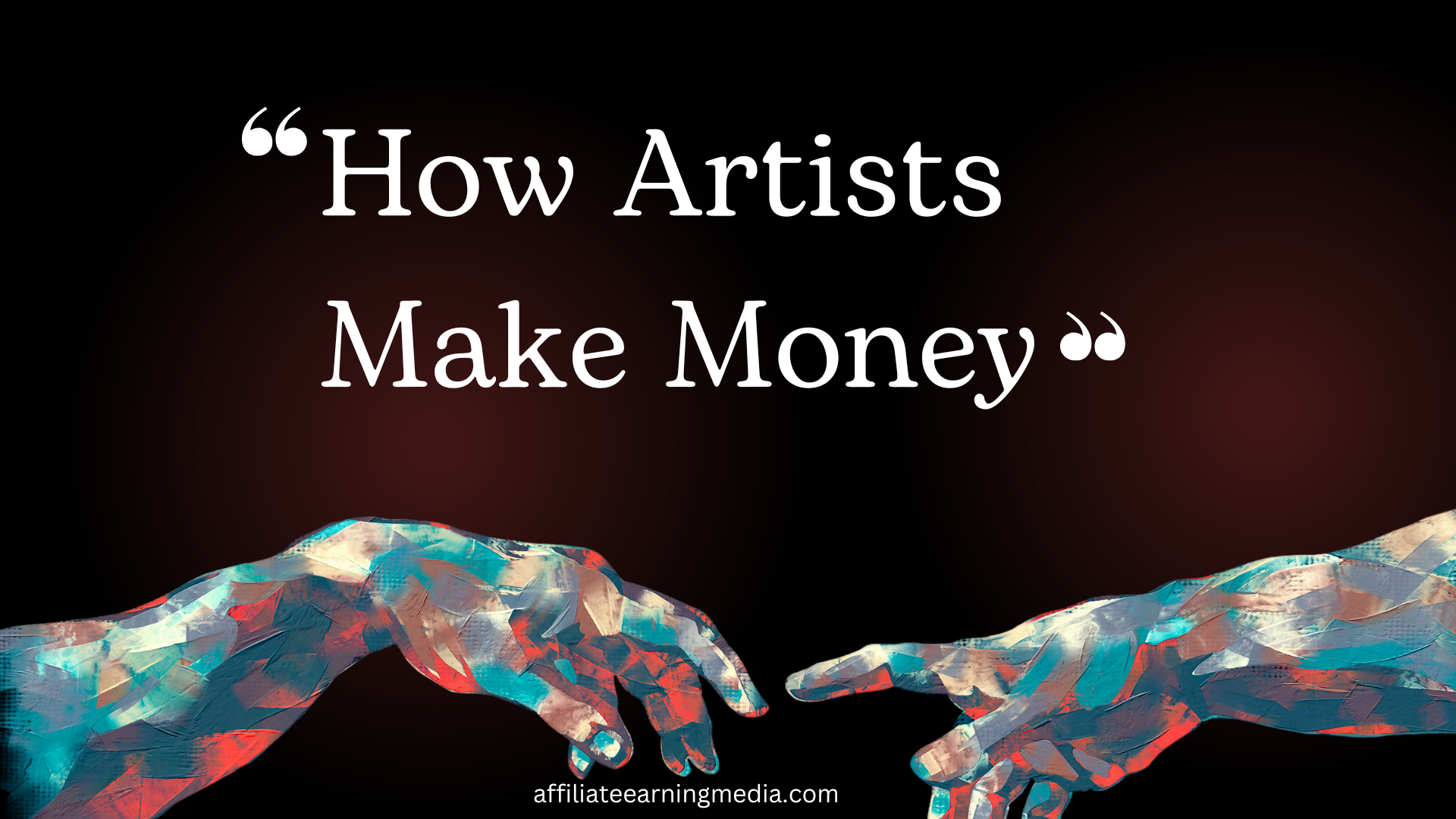Artists have long been admired for their creativity and unique perspectives, but the perception of the starving artist struggling to make a living is far from the complete picture. In reality, artists have developed various avenues to monetize their talents and generate income. This article explores five key ways artists make money, shedding light on the diverse and evolving landscape of the art industry.
Best Recommended and Proven Way to Make Money Online – Watch this FREE Video to START >>

- Selling Artwork: One of the most traditional ways for artists to earn income is by selling their artwork. This can be done through galleries, art fairs, online platforms, or even directly to collectors. Artists establish their value by building a reputation and portfolio, which often increases demand and raises the prices of their creations. Sales can range from original paintings and sculptures to prints, merchandise, and even licensing rights, allowing artists to profit from their artistic expressions.
- Commissions and Custom Work: Artists frequently receive requests for commissioned pieces tailored to specific themes, sizes, or personal preferences. These commissions can come from individuals, businesses, or organizations seeking unique artworks to adorn their homes, offices, or public spaces. Creating custom pieces not only provides artists with a steady income source but also allows them to engage in collaborative projects and expand their artistic range.
- Artistic Services: Artists possess a vast array of skills beyond creating physical artwork. Many artists offer specialized services such as graphic design, illustration, mural painting, art therapy, or teaching workshops and classes. By leveraging their expertise, artists can secure contracts, freelance projects, or ongoing partnerships with clients in need of visual communication, branding, or creative guidance. These services tap into the practical applications of art, enabling artists to earn income while sharing their knowledge and skills.
- Grants, Residencies, and Fellowships: Artists often rely on grants, residencies, and fellowships as valuable sources of funding and support. These opportunities are provided by governments, foundations, cultural institutions, and art organizations. By successfully applying for these programs, artists receive financial aid, studio spaces, materials, mentorship, and exposure. Grants and fellowships not only alleviate some of the financial burdens but also provide artists with dedicated time and resources to focus on their artistic development and experimentation.
- Online Platforms and Social Media: In recent years, the advent of the internet and social media has revolutionized the way artists promote and sell their work. Online platforms such as Etsy, Shopify, and Patreon allow artists to reach a global audience, set up virtual galleries, sell prints and merchandise, or offer exclusive content to patrons. Social media platforms like Instagram, TikTok, and YouTube enable artists to showcase their creative process, build a following, and attract potential buyers. Additionally, artists can monetize their online presence through collaborations, sponsored posts, and brand partnerships.
Contrary to popular belief, artists have a multitude of ways to generate income and sustain their artistic careers. Selling artwork, commissions, artistic services, grants, residencies, and leveraging online platforms all contribute to an artist’s financial well-being. The evolving landscape of the art industry, combined with the power of technology, has provided artists with unprecedented opportunities to showcase their work, reach wider audiences, and connect directly with potential buyers and supporters. By embracing these diverse revenue streams, artists can cultivate a sustainable and fulfilling artistic practice while sharing their creative visions with the world.
Selling Artwork
Selling your artwork can be a daunting task, but it doesn’t have to be. With a little planning and effort, you can successfully market and sell your work to collectors and art lovers alike.
Here are 7 tips to help you get started:
- Know your market. Who are you selling to? What kind of art do they like? What is their budget? Once you know your target market, you can tailor your marketing efforts to reach them.
- Create a strong online presence. This includes having a website or blog where you can showcase your work, as well as being active on social media. Make sure your online presence is professional and polished, and that it reflects your unique artistic style.
- Get involved in the art community. Attend art fairs, open studios, and other events where you can meet potential buyers and collectors. Get involved in online art communities and forums, and network with other artists.
- Price your work competitively. Do some research to see what other artists in your genre are charging for their work. Don’t undervalue your work, but don’t overprice it either.
- Promote your work. Let people know that you’re selling your artwork! Send out press releases, create flyers, and post your work on online marketplaces.
- Offer prints and other merchandise. Not everyone can afford to buy original artwork, but they may be interested in prints or other merchandise. Offering these items can help you reach a wider audience.
- Be patient. It takes time to build a successful art business. Don’t get discouraged if you don’t start selling right away. Keep creating great work, and keep promoting yourself. Eventually, you’ll start to see results.
Commissions and Custom Work
Commissions and custom work can be a great way for artists to make money and build their careers. However, it’s important to understand the process and how to set yourself up for success.
Here are 7 things you need to know about commissions and custom work:
- What is a commission? A commission is a work of art that is created specifically for a client. The client provides the artist with specific instructions, such as the subject matter, style, and size of the artwork.
- What is custom work? Custom work is similar to a commission, but the client has more input into the creative process. The artist may still provide some guidance, but the client ultimately has the final say on the look and feel of the artwork.
- How do I get started with commissions and custom work? The best way to get started is to let people know that you’re open to commissions. You can do this by adding a “Commissions” section to your website or blog, or by mentioning it in your social media posts. You can also reach out to potential clients directly.
- How do I set a price for my commissions and custom work? The price of a commission or custom work will vary depending on the size, complexity, and materials used. It’s important to do your research and price your work competitively. You may also want to consider offering discounts for multiple pieces or for repeat clients.
- What do I need to do to protect myself legally? When you create a commission or custom work, you own the copyright to the artwork. However, the client may also have some rights to the artwork, depending on the terms of the commission. It’s important to have a written contract that outlines these rights and responsibilities.
- How do I manage my time and workload? Commissions and custom work can be time-consuming, so it’s important to manage your time effectively. You may want to set deadlines for yourself and communicate these deadlines to your clients. It’s also important to be realistic about how much work you can take on at a time.
- How do I deliver my commissions and custom work? Once you’ve finished a commission or custom work, you need to deliver it to the client. You may want to deliver the artwork in person, or you may ship it. Make sure to package the artwork carefully to avoid damage in transit.
Artistic Services
Artistic services are a broad category that encompasses a wide range of creative work. This can include anything from painting and drawing to photography and graphic design. Artistic services can be used for a variety of purposes, such as personal expression, commercial use, or educational purposes.
If you are looking for artistic services, there are a few different ways to find them. You can search online for artists in your area, or you can contact local art galleries or studios. You can also ask friends, family, or colleagues for recommendations.
Once you have found a few artists that you are interested in, you will need to decide what type of services you need. Do you need a painting, a drawing, a photograph, or something else? Once you know what you need, you can start to negotiate a price with the artist.
Here are 7 points to consider when hiring an artist for your project:
- What is your budget? Artistic services can range in price from a few hundred dollars to several thousand dollars. It is important to set a budget before you start your search.
- What is your timeline? Some artists have a few weeks to complete a project, while others may need several months. It is important to factor in the timeline when you are making your decision.
- What is your style? Do you have a specific style in mind? If so, make sure to find an artist who works in that style.
- What are your expectations? Be clear about what you expect from the artist. Do you want a finished piece of art, or do you want the artist to provide you with sketches or ideas?
- Get everything in writing. Once you have agreed on a price and a timeline, get everything in writing. This will help to avoid any misunderstandings down the road.
- Be respectful of the artist’s process. Art takes time and effort. Be patient with the artist and respect their process.
- Enjoy the process! Hiring an artist can be a rewarding experience. Be open to new ideas and enjoy the creative process.
Best Recommended and Proven Way to Make Money Online – Watch this FREE Video to START >>
Grants, Residencies, and Fellowships
Grants, residencies, and fellowships are all forms of financial assistance that can help artists and creative professionals pursue their work. These opportunities can provide funding for travel, materials, research, and other expenses. They can also provide opportunities to network with other artists, to exhibit work, and to receive feedback from experts.
If you are an artist or creative professional, there are a few things you need to know about grants, residencies, and fellowships:
- There are many different types of funding opportunities available. Some grants are specifically for artists, while others are open to a wider range of creative professionals. Some grants are for specific projects, while others are for general support.
- The application process can be competitive. There are often many applicants for each grant, so it is important to make sure your application is strong.
- The deadlines for applying for grants can vary. It is important to start your research early and to make sure you submit your applications on time.
Here are 7 tips for finding and applying for grants, residencies, and fellowships:
- Do your research. There are a number of resources available to help you find funding opportunities. You can search online, contact arts organizations, or talk to other artists.
- Start early. The application process can take time, so it is important to start your research early.
- Be clear about your goals. What are you hoping to achieve with the funding? Once you know your goals, you can tailor your application to the specific grant or residency.
- Highlight your accomplishments. What have you done in the past that demonstrates your potential? Be sure to highlight your skills, experience, and accomplishments in your application.
- Write a strong proposal. Your proposal should clearly explain your project, your goals, and how the funding will help you achieve your goals.
- Follow the instructions carefully. Make sure you read the application instructions carefully and that you submit all of the required materials.
- Be patient. The application process can take time. Be patient and don’t give up if you don’t hear back right away.
Best Recommended and Proven Way to Make Money Online – Watch this FREE Video to START >>
Online Platforms and Social Media
Online platforms and social media are two of the most powerful forces shaping the world today. These platforms have revolutionized the way we communicate, consume information, and interact with each other.
Here are 7 points on how online platforms and social media are changing the world:
- They are making the world more connected. Online platforms and social media have made it possible for people all over the world to connect with each other. This has led to a more interconnected world, where people can share ideas and experiences with people from different cultures and backgrounds.
- They are giving people a voice. Online platforms and social media have given people a voice that they never had before. This has allowed people to share their stories, opinions, and experiences with a wider audience. This has led to a more informed and engaged citizenry.
- They are changing the way we consume news. Online platforms and social media have changed the way we consume news. In the past, people would get their news from traditional media outlets, such as newspapers and television. However, today, people are increasingly getting their news from online platforms and social media. This has led to a more personalized and fragmented news landscape.
- They are changing the way we shop. Online platforms and social media have changed the way we shop. In the past, people would go to physical stores to buy products. However, today, people are increasingly shopping online. This has led to a more convenient and efficient way to shop.
- They are changing the way we learn. Online platforms and social media have changed the way we learn. In the past, people would go to school to learn. However, today, people are increasingly learning online. This has led to a more accessible and affordable way to learn.
- They are changing the way we work. Online platforms and social media have changed the way we work. In the past, people would work in traditional office settings. However, today, people are increasingly working remotely. This has led to a more flexible and productive way to work.
- They are changing the way we interact with brands. Online platforms and social media have changed the way we interact with brands. In the past, people would interact with brands through traditional channels, such as advertising and public relations. However, today, people are increasingly interacting with brands through online platforms and social media. This has led to a more direct and personal way to interact with brands.
I appreciate you reading my full article, How Artists Make Money


